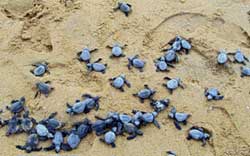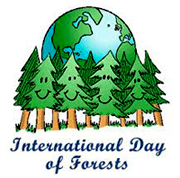March 2019 Environment
Sakshi Education
- Odisha’s Rushikulya rookery awaits Olive Ridleys

Even after waiting for almost a month, Olive Ridley turtles have not yet arrived for mass nesting at Odisha’s Rushikulya rookery and Devi river mouth. The reasons are not fully understood yet.
Mass nesting has already occurred at the Gahirmatha coast of the State. Wildlife Institute of India’s (WII) scientist Bivash Pandav said it could not be said for sure whether mass nesting would occur or not at the Rushikulya rookery this year.
He has studied mass nesting along the Odisha coast over the past decades, mass nesting of Olive Ridleys can occur up to any time till the end of April. Till now, lakhs of impregnated female Olive Ridleys are continuing to congregate in the sea near the Rushikulya rookery, but they aren’t approaching the beach for mass nesting. “Sporadic nesting is continuing at this coast since February. Till now, over 1,000 mother turtles have nested at the Rushikulya rookery.”
“Although it is held that climatic parameters as well as beach conditions decide mass nesting at a coast, we are still not sure how these parameters affect their decision-making,”
The Forest Department has readied six artificial hatcheries to incubate eggs resulting from sporadic nesting.
The beach has been cleaned up. A metal net fences a stretch of over five kilometers from Gokharkuda to Prayagi — this fencing is expected to protect Olive Ridleys and their eggs from predators and human intervention. CCTV cameras continue to keep a watch on the nesting beach.
This year, the Forest Department also prepared a three-km-long coast near the Bahuda river mouth, from Sunapur to Anantpur, as an alternative mass nesting site, about 20 km to the south of Rushikulya. However, except for few occurrences of sporadic nesting, mass nesting has yet not occurred at this new beach.
- IEA report shows China, U.S. & India together accounted for nearly 70% of the rise in energy demand
India emitted 2,299 million tonnes of carbon dioxide in 2018, a 4.8% rise from last year, according to a report by the International Energy Agency (IEA).
India’s emissions growth this year was higher than that of the United States and China — the two biggest emitters in the world and this was primarily due to a rise in coal consumption. China, the United States, and India together accounted for nearly 70% of the rise in energy demand.
India’s per capita emissions were about 40% of the global average and contributed 7% to the global carbon dioxide burden. The United States, the largest emitter, was responsible for 14%.
As per its commitments to the United Nations Framework Convention on Climate Change, India has promised to reduce the emissions intensity of its economy by 2030, compared to 2005 levels. It has also committed to having 40% of its energy from renewable sources by 2030 and, as part of this, installs 100 GW of solar power by 2022.
- Glacier in Greenland grows after years of melting
Jakobshavn glacier, a major Greenland glacier that was one of the fastest shrinking ice and snow masses on Earth, is growing again according to a new NASA study. But scientists are warning it is just temporary. The change was recorded from two airborne missions in 2016 and 2017.
- India’s carbon dioxide emissions up 5%
However, the IEA report showed that India’s energy intensity improvement declined 3% from last year even as its renewable energy installations increased 10.6% from last year.
Global energy consumption in 2018 increased at nearly twice the average rate of growth since 2010, driven by a robust global economy and higher heating and cooling needs in some parts of the world. Demand for all fuels increased, led by natural gas, even as solar and wind posted double digit growth. Higher electricity demand was responsible for over half of the growth in energy needs. Energy efficiency saw lacklustre improvement.
As a result of higher energy consumption, carbon dioxide emissions rose 1.7% last year and hit a new record, the authors of the report said in a press statement.
The United States had the largest increase in oil and gas demand worldwide.
Gas consumption jumped 10% from the previous year, the fastest increase since the beginning of IEA records in 1971.
It will cost at least $2.5trillion (?150 trillion approx.) to implement its climate pledge, around 71% of the combined required spending for all developing country pledges.
- Action to be taken against those rearing African catfish
The Fisheries Department has issued orders to District Collectors asking them to take action against farmers who rear or sell banned African catfish (Clarias gariepinus) called African keluthi.
Recently, there was an order from the National Green Tribunal against the fish, since it is an exotic species and it can compromise our genetic pool.
A former official of the Fisheries Department explained that since the African catfish grew to good sizes when compared to their smaller indigenous counterparts, farmers found it more lucrative and hence reared them on the sly.
- Best way to face climate change is to be friendly with nature – Vice President
Vice President M. Venkaiah Naidu has said that the climate change is the most common challenge faced by the world today and the best way to face climate change is to be friendly with nature and live in harmony with it.
Mr. Naidu said, as People brace themselves to cope with the challenges of climate change, everyone have to marshal all the intelligence, knowledge, science and understanding of nature to do that.
He said that the shared mobility systems, electric vehicles, bicycles and connected vehicles are beginning to occupy center stage in the global mobility systems. These are welcome changes and it will have an impact of reducing traffic congestion, cleaning up the air and reducing the need for parking space.
The Vice President said that the air quality has been a matter of concern and every winter many parts of the country face ambient air quality that is extremely poor. There is need to systematically identify the sources of the problem and deal with them, otherwise it will adversely impact the health and well-being of city residents, especially the children.
- The hump-backed Mahseer is now 'critically endangered'
The hump-backed Mahseer, found in the waters of the Cauvery, has been added to the Red List as Critically Endangered.
This tiger does not have stripes. But the hump-backed Mahseer—a large freshwater fish also called the tiger of the water and found only in the Cauvery river basin (including Kerala’s Pambar, Kabini and Bhavani rivers)—is now “Critically Endangered”: more threatened than the tiger is, as per the International Union for Conservation of Nature’s Red List of Threatened Species.
The fish is one of the 229 species added to the Red List last November; this update also reveals that the threat status of 12 other Indian species, including great hornbills, has increased.
The inclusion of the Mahseer in the Red List, an inventory of the conservation status of the world’s species, was possible only once the fish got its scientific name last June.
They recognize 16 species of Mahseer in India. Now, securing the future of the hump-backed Mahseer would depend on the strong willingness and cooperation of a range of stakeholders in three states—Kerala, Tamil Nadu and Karnataka—in the Cauvery, one of India’s most contested rivers.
Five other species have also made it to threatened categories: two wild orchids, the Arabian scad (a marine fish) and two wild coffee species found only in a few localities in the Western Ghats.
While 31 species that were already in the Red List have been down-listed (since threats are not as significant as earlier thought or due to conservation efforts), the threat status of 12 species has increased.
The great hornbill (found in India and South-East Asia) was earlier categorized as “Near Threatened”. It is now “Vulnerable” due to high hunting pressure coupled with habitat loss and deforestation, while the wreathed hornbill has moved from “Least Concern” to “Vulnerable”.
“There is an increase in conservation action, funding and research when a species is included in the List. But up-listing or down-listing species is a continuous process. The latter is seen as a sign of success so that should be the ultimate aim.”
- Rare Sumatran tiger cubs make public debut at Sydney zoo
Three Sumatran Tiger cubs are released into the enclosure for display to the public for the first time at Taronga Zoo in Sydney . Zookeepers called a “wonderful success” for the future of the critically endangered species. The three Sumatran Tiger cubs were born in January 2019.
Two female cubs — Mawar, which means “rose” in Indonesian, and Tengah Malam (“midnight“) — and their brother Pemanah (“archer”) were allowed outside their closed dens to explore the more natural outdoor tiger compound.
“Now that they are moving about a larger space and learning to climb terrain, she will have a much harder time controlling them.
Sumatran tigers are classified as critically endangered, with as few as 350 remaining in patches of forest on the Indonesia island of Sumatra, where their natural habitat has been devastated by illegal wildlife trade and jungle clearing for palm oil plantations.
“This birth is such a wonderful success for the conservation of this fragile species, and I am so excited that we can now invite guests to share our joy,”
“It’s such a shock that these three little cubs represent one per cent of the remaining wild population, but with zoo-based conservation programs worldwide and the support of our guests here in Sydney, there’s still hope for the future of this species.”
- International Forest Day to be observed on 21st March

Every 21 March the United Nations raises awareness of the importance of all types of forests.
This year (2019) the International Day of Forests promotes education to Learn to Love Forests.
It underscores the importance of education at all levels in achieving sustainable forest management and biodiversity conservation.
Healthy forests mean healthy, resilient communities and prosperous economies.
- Fifteen of the 20 most polluted cities in the world are in India
 Fifteen of the top 20 most polluted cities in the world are located in India, according to an analysis of air quality in several cities around the world.
Fifteen of the top 20 most polluted cities in the world are located in India, according to an analysis of air quality in several cities around the world.
When ranked by country, Bangladesh emerged as the most polluted followed by Pakistan and India respectively.
Of the cities analysed, 64% exceeded the WHO’s annual exposure guideline (10 micrograms/cubic meter) for fine particulate matter, also known as PM2.5. India’s annual guidelines range from 40-60 micrograms/cubic meter, depending on whether they are residential or industrial areas.
Every single one of measured cities with data in the Middle East and Africa exceeded the WHO guideline, while 99% of cities in South Asia, 95% of cities in Southeast Asia and 89% of cities in East Asia breached this level.
The ranking relies on ground-based sensors located in 3,000 cities from 73 countries and was compiled by IQAir Group, a manufacturer of air-monitoring sensors as well as purifiers and environmentalist group Greenpeace.
Jakarta and Hanoi emerged as Southeast Asia’s two most polluted cities and average concentrations in the cities in China fell by 12% from 2017 to 2018. Beijing ranks now as the 122nd most polluted city in the world in 2018 and China, the 12th most polluted country in the world. Of the countries analyzed, Iceland emerged as the one with the cleanest air. - International Forest Day to be observed on 21st March
Published date : 16 Mar 2019 05:16PM


















